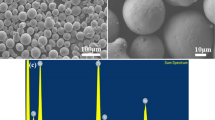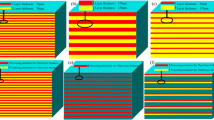Abstract
The degree to which lattice structure fabricated by additive manufacturing (AM) processes matches the original solid model depends on a number of factors, some of which include type of AM process, machine characteristics, and powder utilized. Although some thresholds on dimensions or orientation for 3D-printed simple bars or plates are available in the literature, a large number of variables that influence lattice 3D-printing require thorough investigation. In particular, numerous build orientation for inclined struts, heat dissipation in complex geometry, and structural joints are some unique features of lattices which should be considered while developing associated thresholds. Experimental observation indicated different sizes for similar struts at different locations on a lattice. This requires investigation on the influence of build orientation. In this study, a wide range of strut- and surface-based lattices were designed and fabricated from Ti-6Al-4V in order to study defects and dimensional accuracy. Manufacturability limitations and design considerations were evaluated to achieve a product that was representative of the original design in terms of both geometry and dimensional accuracy. It is demonstrated that below the identified thresholds, the orientation of the lattices on the build-plate influences the homogeneity and dimensional accuracy. Acceptable homogeneity in geometry was achieved for entire lattice structure after orienting 45° around two Cartesian axes. It is demonstrated that support structure should be enough large to facilitate heat dissipation and reduce thermal distortion.

















Similar content being viewed by others
Availability of data and material
Data and material will be available upon request.
Code availability
No code is used in this research.
References
Tang Y, Dong G, Zhou Q, Zhao YF (2018) Lattice structure design and optimization with additive manufacturing constraints. IEEE Trans Autom Sci Eng 15(4):1546–1562
Cabanettes F, Joubert A, Chardon G, Dumas V, Rech J, Grosjean C, Dimkovski Z (2018) Topography of as built surfaces generated in metal additive manufacturing: a multi scale analysis from form to roughness. Precis Eng 52:249–265
Alghamdi A, Downing D, McMillan M, Brandt M, Qian M, Leary M (2019) Experimental and numerical assessment of surface roughness for Ti6Al4V lattice elements in selective laser melting. Int J Adv Manuf Technol 105:1275–1293
Chahid Y, Racasan R, Pagani L, Townsend A, Liu A, Bills P, Blunt L (2021) Addit Manuf 37:101731
Lynch ME, Williams K, Cabrera M, Beccuti T (2021) Surface finishing of additively manufactured IN718 lattices by electrochemical machining. Int J Adv Manuf Technol 113(4):1–18. https://doi.org/10.1007/s00170-020-05699-8
Yuan L, Ding S, Wen C (2019) Additive manufacturing technology for porous metal implant applications and triple minimal surface structures: a review. Bioact Mater 4:56–70
Tancogne-Dejean T, Spierings AB, Mohr D (2016) Additively-manufactured metallic micro-lattice materials for high specific energy absorption under static and dynamic loading. Acta Mater 116:14–28
Gangireddy S, Faierson EJ, Mishra RS (2018) Influences of post-processing, location, orientation, and induced porosity on the dynamic compression behavior of Ti–6Al–4V alloy built through additive manufacturing. J Dyn Behav Mater 4:441–451. https://doi.org/10.1007/s40870-018-0157-3
Gangireddy S, Komarasamy M, Faierson EJ, Mishra RS (2019) High strain rate mechanical behavior of Ti-6Al-4V octet lattice structures additively manufactured by selective laser melting (SLM). Mater Sci Eng A 745:231–239
Harris JA, Winter RE, McShane GJ (2017) Impact response of additively manufactured metallic hybrid lattice materials. Int J Impact Eng 104:177–191
Yan C, Hao L, Hussein A, Raymont D (2012) Evaluations of cellular lattice structures manufactured using selective laser melting. Int J Mach Tools Manuf 62:32–38
Al-Saedi DSJ, Masood SH, Faizan-Ur-Rab M, Alomarah A, Ponnusamy P (2018) Mechanical properties and energy absorption capability of functionally graded F2BCC lattice fabricated by SLM. Mater Des 144:32–44
Scalzo F, Totis G, Vaglio E, Sortino M (2021) Experimental study on the high-damping properties of metallic lattice structures obtained from SLM. Precis Eng 71:63–77
Kang D, Park S, Son Y, Yeon S, Kim SH, Kim I (2019) Multi-lattice inner structures for high-strength and light-weight in metal selective laser melting process. Mater Des 175:107786
Calignano F (2014) Design optimization of supports for overhanging structures in aluminum and titanium alloys by selective laser melting. Mater Des 64:203–213
Su XB, Yang YQ, Yu P, Sun JF (2012) Development of porous medical implant scaffolds via laser additive manufacturing. Trans Nonferrous Metals Soc China 22(Suppl. 1):181–187
Wang X, Xu S, Zhou S, Xu W, Leary M, Choong P, Qian M, Brandt M, Xie YM (2016) Topological design and additive manufacturing of porous metals for bone scaffolds and orthopaedic implants: A review. Biomaterials 83:127–141
Mazur M, Leary M, Sun S, Vcelka M, Shidid D, Brandt M (2016) Deformation and failure behaviour of Ti-6Al-4V lattice structures manufactured by selective laser melting (SLM). Int J Adv Manuf Technol 84:1391–1411
Acknowledgements
The authors appreciate the funding received from Army Research Lab Cooperative Agreement W911NF-18-2-0067 for enabling this work.
Funding
This work was supported by the funding received from Army Research Lab Cooperative Agreement W911NF-18–2-0067.
Author information
Authors and Affiliations
Contributions
All authors contributed to the study conception and design, material preparation, data collection, and analysis.
Corresponding author
Ethics declarations
Ethics approval
Authors approve to follow the Ethical Responsibilities of Authors for this journal.
Consent to participate
All authors read the final manuscript.
Consent for publication
All authors approved the publication of the final manuscript.
Competing interests
The authors declare no competing interests.
Additional information
Publisher's Note
Springer Nature remains neutral with regard to jurisdictional claims in published maps and institutional affiliations.
Rights and permissions
Springer Nature or its licensor (e.g. a society or other partner) holds exclusive rights to this article under a publishing agreement with the author(s) or other rightsholder(s); author self-archiving of the accepted manuscript version of this article is solely governed by the terms of such publishing agreement and applicable law.
About this article
Cite this article
Sereshk, M.R.V., Faierson, E. Study of defects and dimensional accuracy to determine manufacturability thresholds for laser powder bed fusion of Ti-6Al-4V lattices. Int J Adv Manuf Technol 123, 3795–3806 (2022). https://doi.org/10.1007/s00170-022-10325-w
Received:
Accepted:
Published:
Issue Date:
DOI: https://doi.org/10.1007/s00170-022-10325-w




